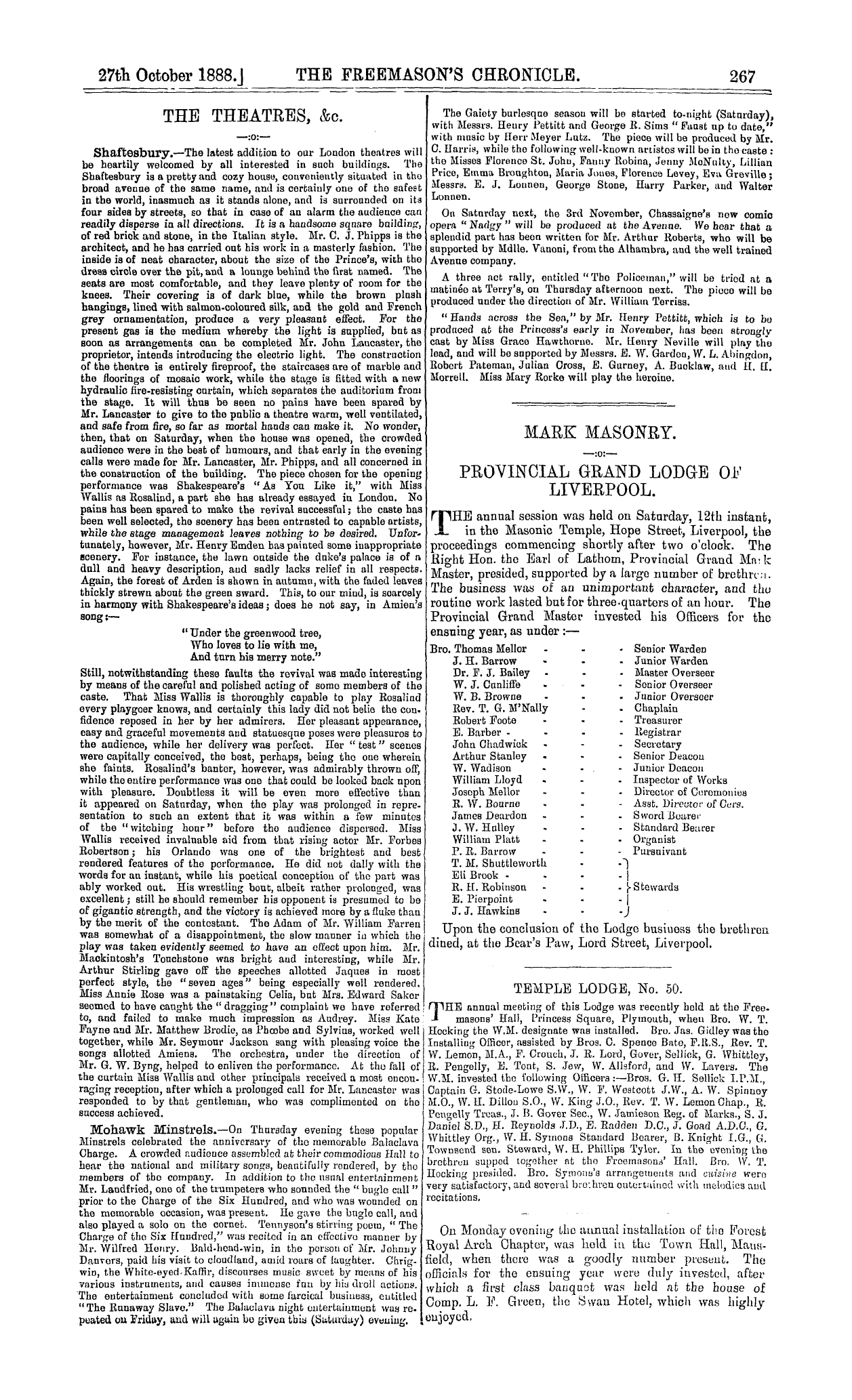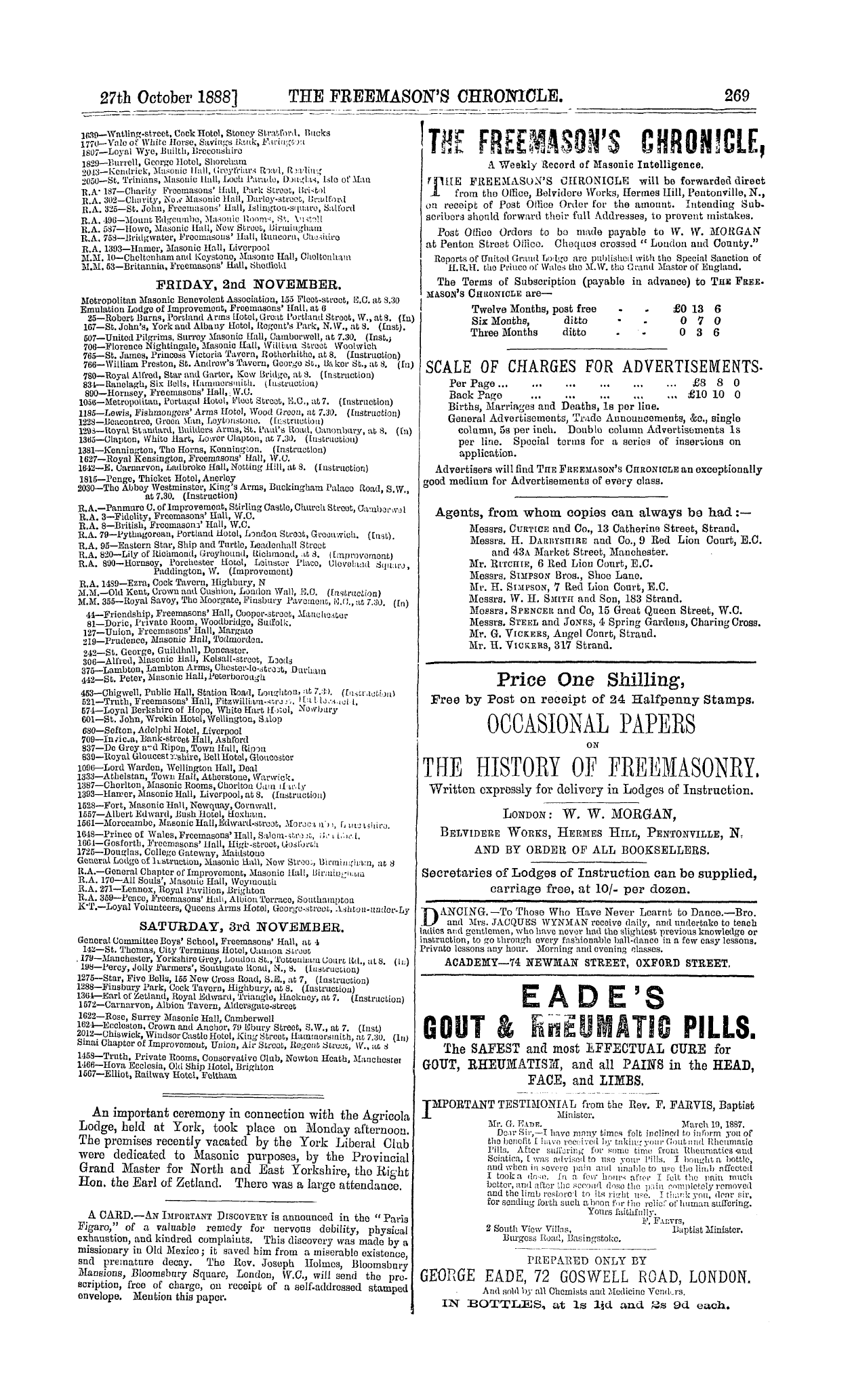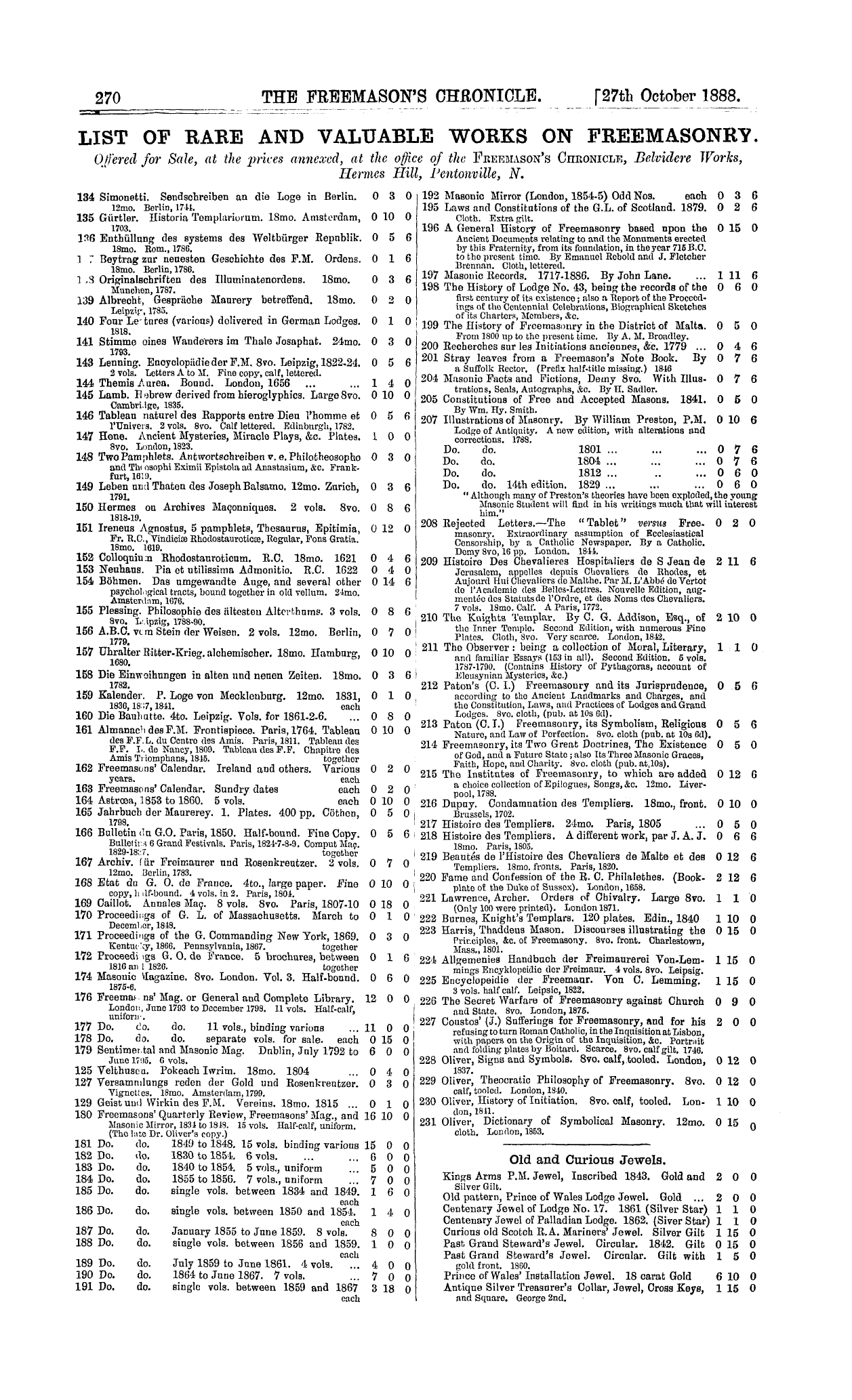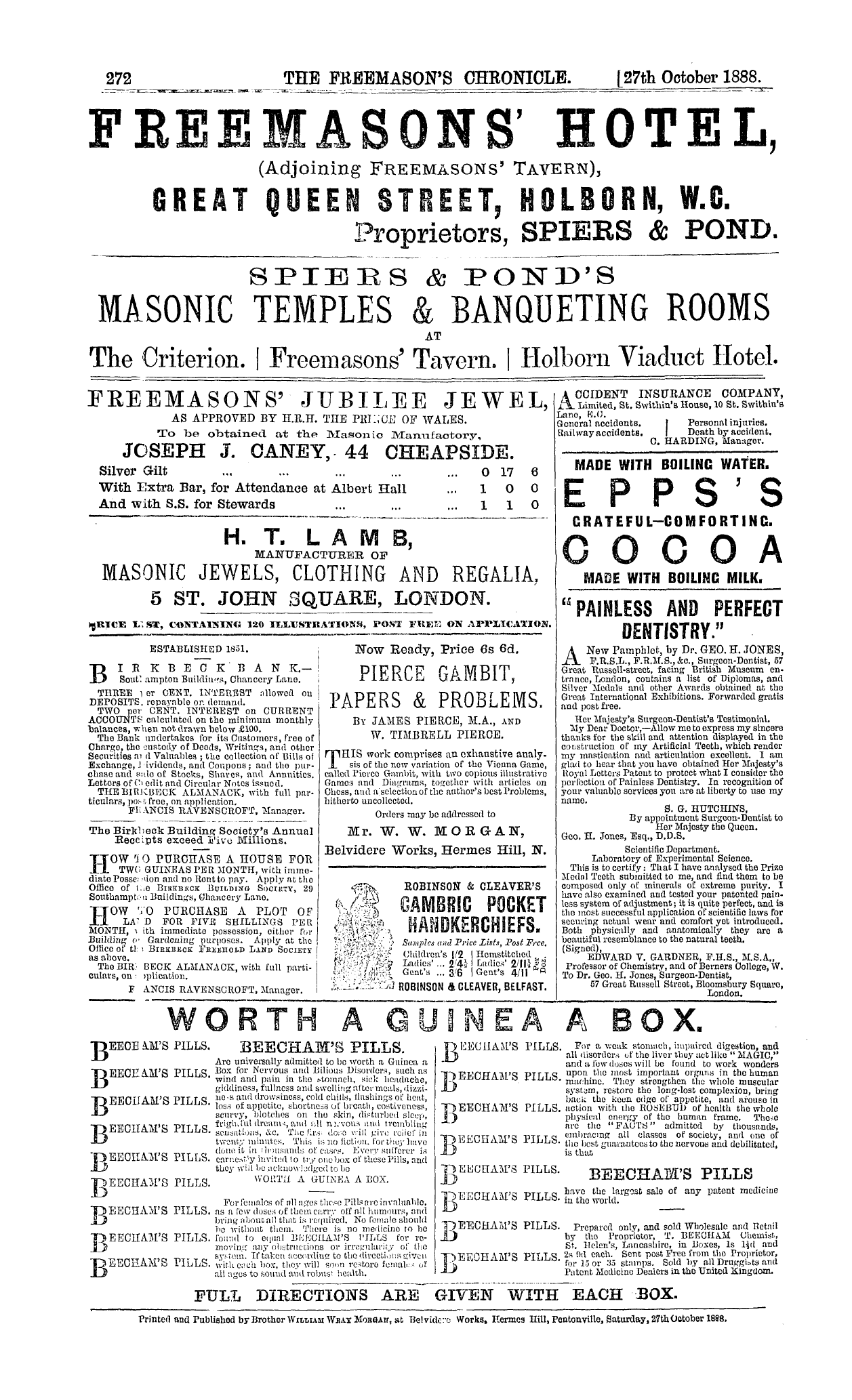-
Articles/Ads
Article COMMENTS ON " FACTS AND FICTIONS." ← Page 2 of 3 Article COMMENTS ON " FACTS AND FICTIONS." Page 2 of 3 →
Note: This text has been automatically extracted via Optical Character Recognition (OCR) software.
Comments On " Facts And Fictions."
and they never had in America more than one word in the third degree . And the " parallel lines " with " Jacob's ladder , " & c , were not manufactured until after 1770 . Thomas Smith Webb first introduced the parallel lines into the
American ritual in 1797 . Whether the parallel lines were manufactured by the Ancients or Moderns I know not . But as the Ancients' ritual was introduced into Pennsylvania before the parallel lines were manufactured , and as the
Pennsylvanian Masons have never innovated from the old ritual , derived as they supposed from Prince Edwin of York , hence they know nothing about tho parallel lines , and if you ask one of them to explain " the point within a
circle , " ho will stare wildly and ask , " What is that ? " The fact is , the Masonic ritual in the last century was tinkered again and again , some things were left out and some things added . It was so in America and it was so wherever Masonry was introduced .
Now , I presume that in Ireland they were also blessed with Masonic improvers and ritual tinkers ; for instance , in the list of English Lodges printed in 1735 in Smith ' s Pocket Companion , No . 79 was vacant , but in the Dublin
edition the Irish reprinter filled up blank space to No . 79 with " Water Street , Philadelphia . " We also know that previous to 1744 the Royal Arch Degree was first planted
in Dublin . The installation of Masters , with words , signs and grips thereunto belonging , was an early Irish invention , and so were the Officers known as " Senior and Junior
Deacons . " Now , every Mason after his initiation is impressed with a belief that the ritual descended to us from King Solomon , that Masons always adhered to ancient landmarks , and that consequently Masons have the same
ritual , word for word , the world over . Now , Bro . Dermott was initiated in Dublin , in 1746 , he was Master of a Lodge in Dublin , and was Royal Archedin Dublin . When , therefore , he came to London and found that the Dublin and
London rituals differed in some respects , he imagined that as they in Dublin had the Royal Arch degree , of which the English Masons knew nothing , the Dublinites , so he thought , ought to be regarded as greater
Masonic luminaries than the Londoners ; hence he was persuaded that the Irish ritual was ancient , or more in accordance with the old ritual of Solomon , or at least of the one used at York in the days of Prince Edwin , and he
therefore may have felt himself justified in doing what he did . But although he must afterwards have been better informed , he still continued to swear , through thick and thin , that his Grand Lodge was ancient and the old one was modern .
But while I admit that changes were made in the English ritual , I cannot believe that the Grand Lodge of England ever sanctioned the transposition of words from one degree to another ; and though an additional word was
sanctioned in one degree , the rotation of the words were never changed by its authority . I know that such is the case in some jurisdictions on the Continent . But I suspect that the change was introduced there by a German , who
introduced an English ritual into Hamburg late in the last century , and that he belonged in London to a Lodge of the Ancients . Bro . Speth may know something about this ; but whether the said German brother made the change , or
whether the Ancients did it I do not know ; but I do not believe that the 1717 Grand Lodge ever authorised such a change ; and if neither of the London Grand Lodges authorised
the transposition of words , then the said bodies differed only in nothing more important than tiveedledee and tweedledum .
I will now proceed to give some of Bro . Sadler ' s quotations from the records , upon which he bases his theory , that important changes were authorised by the Grand
Lodge of England , m or soon after 1730 . He says , p 157 "In the regular Grand Lodge , April 12 th 1809 , the following resolution was passed , printed in the report , and circulated among the Lodges under its jurisdiction , viz .:
" That this Grand Lodge do agree in opinion with the Committee of Charity ; that it is not necessary any longer to continue in force those measures which were resorted to
in or about the year 1739 , respecting irregular Masons , and do therefore enjoin the several Lodges to revert to the Ancient landmarks of the Society . " Upon which Bro . Sadler remarks : " We have in this resolution two very important admissions on the part of the body from which it emanated ,
namely , that they had previously departed from the ancient landmarks of the Order , and were ignorant of the precise period when this event occurred . "
Comments On " Facts And Fictions."
Now , with all due respect to Bro . Sadler , I be » to say that I do not believo that tho Committee of Charity of 1809 , or those who passed the abovo resolution , really and truly knew what the ancient landmarks were . All the said
worthies knew about 1739 thoy learned from Preston ' s writings , whose authority even Bro . Sadler discards . The fact is , the said resolution was passed preparatory to briuging about a union between the Moderns and Ancients , and
the intention was to removo the prohibition of free intercourse between them . It was already then contemplated to form a peace making Lodge , for the two parties to meet in for discussion as to what was ancient . And such a
Lodge was chartered by the Moderns on the 26 th October following . The leaders of the Ancients also passed resolutions in order to facilitate a union , and a short time after the new Lodge , which was named " The Lodge of Promulgation , " invited the leading ancients to dine with them , and
to become friends , & c . On the 13 th of December 1809 , the Lodge of Promulgation resolved" That Deacons ( being proved on due investigation to be
not only Ancient , but useful and necessary Officers ) be recommended . " The above resolution furnished Bro . Sadler positive proof that the Moderns were guilty of neglecting the appointment
of Deacons , which tho Committee itself admitted to have been an ancient landmark . The fact is , the worthy luminaries who drew up the above resolution were as ignorant about ancient Mason usage ? , as they were about
the man in the moon . Thus , Bro . Lyon informs us , that either a Deacon or a Warden used to preside over the old Lodges , and at one time ( see p 153 ) the Deaconship and Wardenship were united in the same person . The Operative
Lodge at Kelso had a Master and one Warden up to 1742 , but it had no Deacons at all until after it enrolled itself
under the Grand Lodge of Scotland in 1754 or later , aud the Alnwick Lodge , which remained independent from 1701 to about 1757 , had a Master and two Wardens , but it never had Deacons ; and I do not believe that any pre 1717 Lodge ever had two Deacons at the same time . Deacons , therefore , were not an ancient landmark .
On the 19 th of October 1800 , the above named Lodge " Resolved that the ceremony of Installing Masters of Lodges is one of the two landmarks of the Craft , and ought to be
observed . " Upon which Bro . Sadler makes the following comments , viz . : —¦ " It is , therefore , perfectly clear that the Moderns had
certainly for many years dispensed with the ceremony of installation , while their rivals had kept up tho old custom in this respect , as will be seen by reference to their extracts from their records /' Now , until Bro . Sadler proves that the Ancients' form of
installation of Masters of Lodges was truly ancient , or even as old as 1723 , the Moderns cannot be said to have suspended the ceremony of installation , for they never had such a ceremony . Again , the Ancients observed St . John ' s Day , but the
Moderns ceased to observe it after 1730 ; hence our worthy brother imagines that the Moderns were guilty of removing an ancient landmark . The truth , however , is , the observance of Saint John ' s Day is not an ancient landmark at all ; thus , in olden times , when Catholicism was supreme in Christendom , every guild or Lodge had
to have a patron saint , but not necessarily St . John ; thus in Germany in the fifteenth century , as well as in England , the " four holy martyrs " were the Masons '
patron saints . Alnwick Lodge had St . Michael ' s for its saint , and observed his day as long as it lasted . Kilwinning Lodge observed St . Thomas ' s Day till 1780 , but as I have enumerated in former communications the different
saints who were formerly revered as patrons in different Lodges , I shall only now say , that while Lodge membership was confined to Roman Catholics , Lodge prayer could consistently be addressed to the Virgin and to saints . But
after the Reformation , when Lodges were composed of members of both religions , prayers to the Virgin and to saints had to cease , but prayers to the Trinity , and the
observances of saints' days , which offended neither party , were retained . And for a like reason , when the Constitution was so changed as to admit good and true men of all religions , le they what they may , if Christians had obeyed
the " Golden Rule , " every sectarian allusion would have been omitted from the ritual . Unfortunately , the meeting of the four London Lodges in 1717 WAS held on St . John ' s
Note: This text has been automatically extracted via Optical Character Recognition (OCR) software.
Comments On " Facts And Fictions."
and they never had in America more than one word in the third degree . And the " parallel lines " with " Jacob's ladder , " & c , were not manufactured until after 1770 . Thomas Smith Webb first introduced the parallel lines into the
American ritual in 1797 . Whether the parallel lines were manufactured by the Ancients or Moderns I know not . But as the Ancients' ritual was introduced into Pennsylvania before the parallel lines were manufactured , and as the
Pennsylvanian Masons have never innovated from the old ritual , derived as they supposed from Prince Edwin of York , hence they know nothing about tho parallel lines , and if you ask one of them to explain " the point within a
circle , " ho will stare wildly and ask , " What is that ? " The fact is , the Masonic ritual in the last century was tinkered again and again , some things were left out and some things added . It was so in America and it was so wherever Masonry was introduced .
Now , I presume that in Ireland they were also blessed with Masonic improvers and ritual tinkers ; for instance , in the list of English Lodges printed in 1735 in Smith ' s Pocket Companion , No . 79 was vacant , but in the Dublin
edition the Irish reprinter filled up blank space to No . 79 with " Water Street , Philadelphia . " We also know that previous to 1744 the Royal Arch Degree was first planted
in Dublin . The installation of Masters , with words , signs and grips thereunto belonging , was an early Irish invention , and so were the Officers known as " Senior and Junior
Deacons . " Now , every Mason after his initiation is impressed with a belief that the ritual descended to us from King Solomon , that Masons always adhered to ancient landmarks , and that consequently Masons have the same
ritual , word for word , the world over . Now , Bro . Dermott was initiated in Dublin , in 1746 , he was Master of a Lodge in Dublin , and was Royal Archedin Dublin . When , therefore , he came to London and found that the Dublin and
London rituals differed in some respects , he imagined that as they in Dublin had the Royal Arch degree , of which the English Masons knew nothing , the Dublinites , so he thought , ought to be regarded as greater
Masonic luminaries than the Londoners ; hence he was persuaded that the Irish ritual was ancient , or more in accordance with the old ritual of Solomon , or at least of the one used at York in the days of Prince Edwin , and he
therefore may have felt himself justified in doing what he did . But although he must afterwards have been better informed , he still continued to swear , through thick and thin , that his Grand Lodge was ancient and the old one was modern .
But while I admit that changes were made in the English ritual , I cannot believe that the Grand Lodge of England ever sanctioned the transposition of words from one degree to another ; and though an additional word was
sanctioned in one degree , the rotation of the words were never changed by its authority . I know that such is the case in some jurisdictions on the Continent . But I suspect that the change was introduced there by a German , who
introduced an English ritual into Hamburg late in the last century , and that he belonged in London to a Lodge of the Ancients . Bro . Speth may know something about this ; but whether the said German brother made the change , or
whether the Ancients did it I do not know ; but I do not believe that the 1717 Grand Lodge ever authorised such a change ; and if neither of the London Grand Lodges authorised
the transposition of words , then the said bodies differed only in nothing more important than tiveedledee and tweedledum .
I will now proceed to give some of Bro . Sadler ' s quotations from the records , upon which he bases his theory , that important changes were authorised by the Grand
Lodge of England , m or soon after 1730 . He says , p 157 "In the regular Grand Lodge , April 12 th 1809 , the following resolution was passed , printed in the report , and circulated among the Lodges under its jurisdiction , viz .:
" That this Grand Lodge do agree in opinion with the Committee of Charity ; that it is not necessary any longer to continue in force those measures which were resorted to
in or about the year 1739 , respecting irregular Masons , and do therefore enjoin the several Lodges to revert to the Ancient landmarks of the Society . " Upon which Bro . Sadler remarks : " We have in this resolution two very important admissions on the part of the body from which it emanated ,
namely , that they had previously departed from the ancient landmarks of the Order , and were ignorant of the precise period when this event occurred . "
Comments On " Facts And Fictions."
Now , with all due respect to Bro . Sadler , I be » to say that I do not believo that tho Committee of Charity of 1809 , or those who passed the abovo resolution , really and truly knew what the ancient landmarks were . All the said
worthies knew about 1739 thoy learned from Preston ' s writings , whose authority even Bro . Sadler discards . The fact is , the said resolution was passed preparatory to briuging about a union between the Moderns and Ancients , and
the intention was to removo the prohibition of free intercourse between them . It was already then contemplated to form a peace making Lodge , for the two parties to meet in for discussion as to what was ancient . And such a
Lodge was chartered by the Moderns on the 26 th October following . The leaders of the Ancients also passed resolutions in order to facilitate a union , and a short time after the new Lodge , which was named " The Lodge of Promulgation , " invited the leading ancients to dine with them , and
to become friends , & c . On the 13 th of December 1809 , the Lodge of Promulgation resolved" That Deacons ( being proved on due investigation to be
not only Ancient , but useful and necessary Officers ) be recommended . " The above resolution furnished Bro . Sadler positive proof that the Moderns were guilty of neglecting the appointment
of Deacons , which tho Committee itself admitted to have been an ancient landmark . The fact is , the worthy luminaries who drew up the above resolution were as ignorant about ancient Mason usage ? , as they were about
the man in the moon . Thus , Bro . Lyon informs us , that either a Deacon or a Warden used to preside over the old Lodges , and at one time ( see p 153 ) the Deaconship and Wardenship were united in the same person . The Operative
Lodge at Kelso had a Master and one Warden up to 1742 , but it had no Deacons at all until after it enrolled itself
under the Grand Lodge of Scotland in 1754 or later , aud the Alnwick Lodge , which remained independent from 1701 to about 1757 , had a Master and two Wardens , but it never had Deacons ; and I do not believe that any pre 1717 Lodge ever had two Deacons at the same time . Deacons , therefore , were not an ancient landmark .
On the 19 th of October 1800 , the above named Lodge " Resolved that the ceremony of Installing Masters of Lodges is one of the two landmarks of the Craft , and ought to be
observed . " Upon which Bro . Sadler makes the following comments , viz . : —¦ " It is , therefore , perfectly clear that the Moderns had
certainly for many years dispensed with the ceremony of installation , while their rivals had kept up tho old custom in this respect , as will be seen by reference to their extracts from their records /' Now , until Bro . Sadler proves that the Ancients' form of
installation of Masters of Lodges was truly ancient , or even as old as 1723 , the Moderns cannot be said to have suspended the ceremony of installation , for they never had such a ceremony . Again , the Ancients observed St . John ' s Day , but the
Moderns ceased to observe it after 1730 ; hence our worthy brother imagines that the Moderns were guilty of removing an ancient landmark . The truth , however , is , the observance of Saint John ' s Day is not an ancient landmark at all ; thus , in olden times , when Catholicism was supreme in Christendom , every guild or Lodge had
to have a patron saint , but not necessarily St . John ; thus in Germany in the fifteenth century , as well as in England , the " four holy martyrs " were the Masons '
patron saints . Alnwick Lodge had St . Michael ' s for its saint , and observed his day as long as it lasted . Kilwinning Lodge observed St . Thomas ' s Day till 1780 , but as I have enumerated in former communications the different
saints who were formerly revered as patrons in different Lodges , I shall only now say , that while Lodge membership was confined to Roman Catholics , Lodge prayer could consistently be addressed to the Virgin and to saints . But
after the Reformation , when Lodges were composed of members of both religions , prayers to the Virgin and to saints had to cease , but prayers to the Trinity , and the
observances of saints' days , which offended neither party , were retained . And for a like reason , when the Constitution was so changed as to admit good and true men of all religions , le they what they may , if Christians had obeyed
the " Golden Rule , " every sectarian allusion would have been omitted from the ritual . Unfortunately , the meeting of the four London Lodges in 1717 WAS held on St . John ' s















